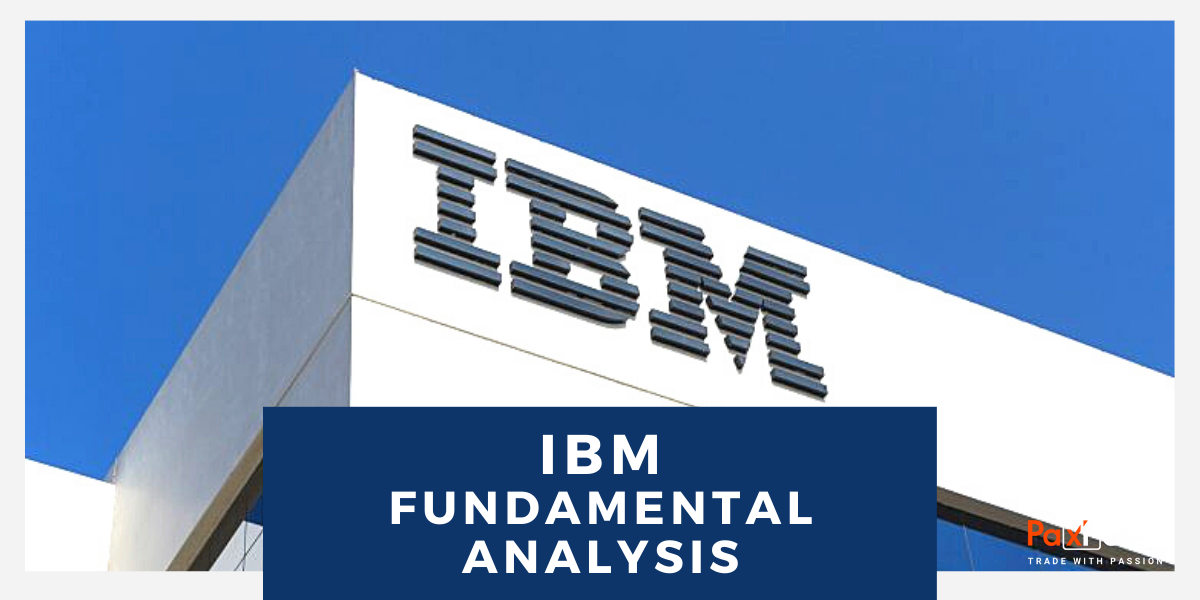
Source: PaxForex Premium Analytics Portal, Fundamental Insight
Over the past three years, IBM stock was down about 5%, while the S&P 500 was up about 50%. Numerous investors have neglected the stock of the aging tech giant as management struggled to generate steady revenue growth.
The ongoing downturn in IBM's business software, hardware, and IT services divisions offset growth in new cloud-focused divisions, and investors lost patience with the company's sluggish recovery efforts.
IBM attempted to back those efforts by acquiring Red Hat for $34 billion three years ago. In 2020, Red Hat's revenue surged 18 percent, but IBM's overall revenue still fell 5 percent as the company struggled with pandemic-related outages.
Last April, Arvind Krishna, IBM's head of cloud, became the company's new CEO to expand the company's presence in the hybrid cloud and artificial intelligence (AI) markets. Six months later, IBM announced the spin-off of its Managed Infrastructure Services division from its Global Technology Services division.
When that spin-off is completed later this year, the "new" IBM will continue to expand its hybrid cloud and artificial intelligence business, as the new division, Kyndryl, will take over one of the company's slowest-growing businesses.
IBM's plan to spin off IBM hasn't caught the fancy of many investors, but the company recently held an investor briefing to explain those ideas and draw its financial objectives. Let's take a look at the key takeaways from that presentation and see how they may influence IBM's stock price over the next few years.
IBM believes it will be able to deliver "sustained single-digit revenue growth on average" from 2022 to 2024, or about $3 billion in new revenue per year. The company expects growth in hybrid cloud, consulting, and security to offset slower growth in the other infrastructure areas.
After Kyndryl's spin-off, IBM expects more revenue to come from its faster-growing software and consulting divisions. These high-growth segments accounted for 55% of the company's revenue in 2020, but that share will rise to about 70% after the spin-off. The software divisions, which IBM keeps, brought in 45% of recurring revenue in 2020, but that percentage will rise to 65% after the spin-off.
After the spin-off, IBM will reduce its reportable segments from five to four: Consulting (29% of recurring revenue in 2020), Software (42%), Infrastructure (25%), and Finance (2%).
The Consulting business will provide business transformation, technology consulting, and application operation services. The company expects this segment to deliver high single-digit sales growth from 2022 to 2024, with pre-tax profit margins in the low tens.
The software business will include Red Hat and IBM's hybrid cloud, artificial intelligence, security, and transaction processing divisions. The company expects Red Hat sales to grow by tens of percent, and the entire software segment will deliver mid-single-digit sales growth with pre-tax profitability of nearly 30 percent.
The infrastructure business will include IBM hardware products and services for infrastructure, public cloud, and edge computing services. IBM expects revenue growth in this segment to remain roughly flat over the medium term, with pretax profit margins of about a dozen percent.
IBM expects these improvements to result in free cash flow (FCF) increases in the high single digits each year between 2022 and 2024. According to this estimate, annual FCF growth will be about $750 million, and cumulative FCF will reach $35 billion over the next three years. IBM plans to return some of that cash to shareholders and use the rest for new investments.
Investors should await IBM to spend more cash on investments and acquisitions, primarily to extend its software and consulting business, rather than buy back its stock or increase its dividend. IBM and Kyndryl will initially pay a combined dividend equivalent to IBM's current dividend, but both companies may cut their payouts after going their separate ways.
IBM's plans sound promising, but the company still faces stiff competition in the software and consulting markets. Amazon and Microsoft are expanding their public cloud platforms into the hybrid cloud market with "virtual private clouds," and faster-growing IT companies such as Accenture and Globant are breaking into the consulting market.
But if IBM achieves its growth targets, its stock could rise again. Right now, the stock looks very cheap at 12 times forward earnings, and it could become even more attractive once Kyndryl spins off. If you've already bought IBM, you should hold your stock and see if the three-year turnaround plans pay off. But if you don't already own the company's stock, you should wait for the spin-off deal to close before taking a fresh look at a "renewed" IBM.
As long as the price is above the 139.80 level, follow the recommendations below::
- Time frame: D1
- Recommendation: long position
- Entry point: 143.32
- Take Profit 1: 149.70
- Take Profit 2: 149.50
Alternative scenario:
If the level of 139.80 is broken-down, follow the recommendations below:
- Time frame: D1
- Recommendation:short position
- Entry point: 139.80
- Take Profit 1: 136.10
- Take Profit 2: 133.90













